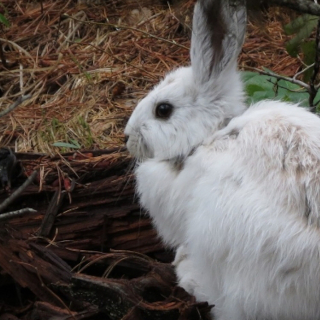Restoring larch forests without hurting hares
We are pleased to announce that our research on the effects of western larch restoration on snowshoe hares was recently published in Restoration Ecology.
As many of you are probably all too aware, humans have drastically altered many ecosystems often with negative consequences. Such is the case with western larch (Larix occidentalis) a native conifer species to Montana that actually drops it needles in the fall similar to its broadleaf cousins. Larch is also a highly desirable timber species partly because its wood is very hard and very strong. As such, western larch has been extensively harvested. In addition, we have compounded the negative effects of extensive harvesting by manipulating the fire regime where larch occurs. Larch need the heat from fires to germinate but, we have actively suppressed fire in this region for the last 100 years. The combined effects of harvesting larch and reducing wildfires have lead to old growth stands of extremely large larch trees being replaced with thick stands of larch saplings.
Larch stands also provide a home for snowshoe hares. Hares are an important species for northern forests because they are a source of food for all sorts of predators such as lynx and coyotes. Because a lot of critters want to eat them, snowshoe hares have also evolved to match their fur color to their environment with hare hair (pun intended) turning white in the winter and brown in the summer to match the surroundings.
The first objective of this project was to begin the process of restoring old growth large stands. We accomplished this by bringing in the Lolo National Forest Missoula Ranger District fire crew (thanks guys for all you awesome work!) to find the biggest larch trees left and cut down all the nearby trees to allow these big trees to grow faster without competition. This type of treatment is called a “doughnut thin” because the shape of the area with cut trees resembles a big (but sadly inedible) doughnut.
Our second objective was to determine the effects that restoring larch might have on snowshoe hares. Many larch stands are in federal lands designated as critical lynx habitat. Because cutting down trees has generally been shown to negatively impact lynx and their most tasty snack, hares, this practice has been banned on all critical lynx habitat. However, in order to restore larch some thinning (cutting some but not all trees) needs to take place. By monitoring the number of hares present and how likely they are to survive both before and after the restoration treatment, we were able to show that this small scale thinning does not negatively affect hares!
Thus, we have demonstrated that we can begin the process of restoring larch stands without having detrimental effects on important wildlife like snowshoe hares.
Full Article: Restoring larch forests without hurting hares
- Alex
Feature Photo - A Missoula fire crew member in action cutting down trees to restore western larch. Photo © Alex Kumar.
The Lolo National Forest Missoula Ranger District fire crew heading out to begin restoring the western larch stand. Photo © Alex Kumar.
After the restoration treatment lone larch trees now have room to grow big and tall. Photo © Alex Kumar.

Alex with a baby snowshoe hare (leveret). Photo © Kyle Garrison.
